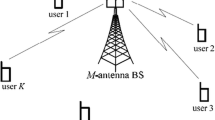Abstract
Faster development of smart electronic devices in recent years along with significant increase in demanding higher data rates has made cognitive radio networks (CRNs) to be taken into consideration as a promising technology. A CRN has the ability to increase spectral efficiency (SE) of communication systems by opportunistically using unused spectrums. Furthermore, Massive multiple-input multiple-output is a major candidate to be used in next generation cellular systems in light of its great capabilities to improve system performance from spectral as well as energy efficiency standpoint. In this paper, we propose a CRN whose base station, as well as the primary base station (PBS) are equipped with large numbers of antennas. We derive closed-form expressions for SE in the uplink of primary users for three different scenarios. In these scenarios perfect and imperfect channel state information are considered separately. In addition, the impact of pilot contamination due to the correlation among users’ pilot signals on sum SE of primary network is examined. For the first two scenarios, minimum number of antennas (MNA) at the PBS to achieve a specified SE is derived in a closed-form expression. MNA is analyzed numerically for the third scenario.




Similar content being viewed by others
References
Haykin, S. (2005). Cognitive radio: Brain-empowered wireless communications. IEEE Journal on Selected Areas in Communications, 23(2), 201–220.
Goldsmith, A., Jafar, S. A., Maric, I., & Srinivasa, S. (2009). Breaking spectrum gridlock with cognitive radios: An information theoretic perspective. Proceedings of the IEEE, 97(5), 894–914.
Wang, B., & Liu, K. J. (2011). Advances in cognitive radio networks; a survey. IEEE Journal of Selected Topics in Signal Processing, 5(1), 5–23.
Marzetta, T. L. (2010). Noncooperative cellular wireless with unlimited numbers of base station antennas. IEEE Transactions on Wireless Communications, 9(11), 3590–3600.
Lu, L., Li, G. Y., Swindlehurst, A. L., Ashikhmin, A., & Zhang, R. (2014). An overview of massive MIMO: Benefits and challenges. IEEE Journal of Selected Topics in Signal Processing, 8(5), 742–758.
Ngo, H. Q., Larsson, E. G., & Marzetta, T. L. (2013). Energy and spectral efficiency of very large multiuser MIMO systems. IEEE Transactions on Communications, 61(4), 1436–1449.
Wang, L., Ngo, H. Q., Elkashlan, M., Duong, T. Q., & Wong, K. (2017). Massive MIMO in spectrum sharing networks: Achievable rate and power efficiency. IEEE Systems Journal, 11(1), 20–31.
Filippou, M., Gesbert, D., & Yin, H. (2012). Decontaminating pilots in cognitive massive MIMO networks. In International Symposium on Wireless Communication Systems (pp. 816–820).
Kouassi, B., Ghauri, I., & Deneire, L. (2013). Reciprocity-based cognitive transmissions using a MU massive MIMO approach. In IEEE International Conference on Communications (ICC) (pp. 2738–2742).
Xie, H., Wang, B., Gao, F., & Jin, S. (2016). A full-space spectrum-sharing strategy for massive MIMO cognitive radio systems. IEEE Journal on Selected Areas in Communications, 34(10), 2537–2549.
Björnson, E., Larsson, E. G., & Debbah, M. (2016). Massive MIMO for maximal spectral efficiency: How many users and pilots should be allocated? IEEE Transactions on Wireless Communications, 15(2), 1293–1308.
Kay, S. M. (1993). Fundamentals of statistical signal processing: Estimation theory. Englewood Cliffs, NJ: Prentice-Hall.
Author information
Authors and Affiliations
Corresponding author
Rights and permissions
About this article
Cite this article
Kashi, A., Abolhassani, B. Uplink Spectral Efficiency Analysis for a Massive MIMO Primary Network. Wireless Pers Commun 98, 407–419 (2018). https://doi.org/10.1007/s11277-017-4875-y
Published:
Issue Date:
DOI: https://doi.org/10.1007/s11277-017-4875-y




